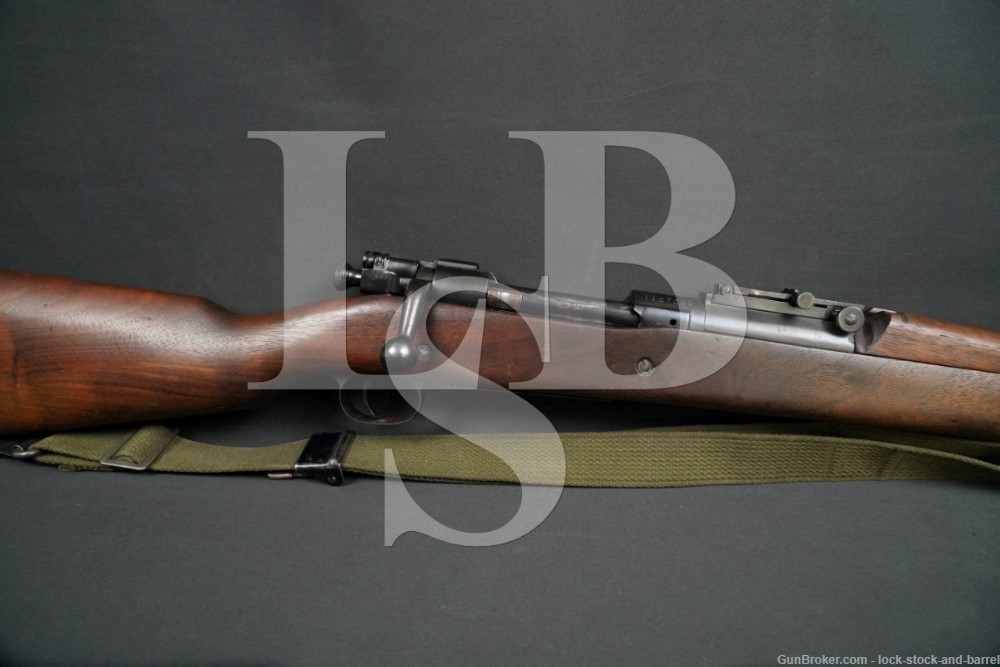
Springfield 1903 Mark I Pedersen Device .30-06 Bolt Action Rifle 1919 C&R
SOLD FOR: $1146
LSB#: 220110JA004
Make: Springfield Armory
Model: 1903 Mark I. The Mark I Rifle was made with an ejection port cutout on the receiver. The ejection port is needed for the Pedersen Device.
Serial Number: 1127399
Year of Manufacture: 1919 (page 373 of Joe Poyer’s book, The Model 1903 Springfield Rifle and its Variations, 3rd Edition).
Barrel Date: June, 1942
M1903 Mk I Rifles were produced from early 1918 to 1920 with a serial number range from 1,034,502 to 1,197,834 (page 31).
Caliber: .30-06 Springfield
Action Type: Bolt Action, Internal Magazine
Markings: The top of the receiver is marked “U.S. / SPRINGFIELD / ARMORY / MODEL 1903 / MARK I / 1127399”. The top of the Springfield Armory barrel is marked “S A / flaming bomb / 6 – 42” . The safety is marked “SAFE READY” and the magazine cutoff is marked “ON OFF”. The bottom of the bolt handle is marked with a faded stamping and a punch mark. The right rear of the bolt body and rear of the safety lever are each marked “R” for Remington. The barrel band is marked “U”. The bayonet lug is marked “H”. The bottom of the grip is marked with a faded “boxed P” proof. The left side of the stock, above the trigger, is marked with an Arsenal Rebuild stamp from the Augusta Arsenal “AAHO”. It is also marked “AOW”. The “AOW” mark is not listed in our reference book. Our research indicates that it is most likely an Arsenal Rebuild stamping from Anniston Arsenal. The scallop for the magazine cutoff is marked “S” for Springfield.
Barrel Length: Approximately 24 Inches
Sights / Optics: The front sight is a pinned blade set in a barrel mounted base. The rear sight is a “U” notched blade attached to a fully adjustable sight ladder marked from “3-27”. When flipped up separate notches and an aperture on the ladder can be used for sighting.
Stock Configuration & Condition: The two piece hardwood stock has a pistol grip, metal nosecap with bayonet lug, stacking loop, barrel band, 2 sling loops, 2 through bolts, and a metal buttplate with hinged door for storage. The refinished buttplate shows surface erosion. The nosecap shows oxidation. The wood shows scattered scrapes, scratches and compression marks. Some of the marks have damaged small portions of the surface wood. These marks have been oiled over. The LOP measures 13 1/8 inches from the front of the trigger to the back of the buttplate. The stock rates in about Very Good Plus overall condition.
Type of Finish: Blue
Finish Originality: Refinished
Bore Condition: The muzzle and grooves are light gray. The rifling is deep. There is erosion in the grooves and at the muzzle. The bore shows an M.E. of 1.
Overall Condition: This rifle retains about 90% of its metal finish as refinished. The metal shows scattered scrapes & small scratches. The metal also shows a freckling of surface erosion and oxidation. The bolt and ejection port show operational wear. The screw heads show use but are refinished. The markings are deep. Overall, this rifle rates in about Very Good condition as refinished.
Mechanics: The action functions correctly. We did not fire this rifle. As with all used firearms, a thorough cleaning may be necessary to meet your maintenance requirements.
Box, Paperwork & Accessories: The rifle comes with a green canvas sling. The canvas shows discoloration & soiling. The metal shows oxidation & scrapes. Overall it is in about Very Good Plus condition.
Our Assessment: This is a collectible Springfield Armory Model 1903 Mark I Rifle. It has been Arsenal Refurbished twice and is marked accordingly on the stock. The rifle has since been refinished. The new metal finish has some issues but should clean up. This 1903 Mark I is over 100 years old and is historically significant. The rifle still has clear markings on the metal that add its history.
This 1903 Mark I was made to accept the Pedersen Device. The Pedersen Device replaced the bolt assembly and accepted a 40 round .30 caliber (pistol caliber) magazine. The Pedersen Device was meant to multiply the firepower of the individual rifleman. The rifleman carried 5 magazines for a total of 200 pistol caliber rounds. This was ideal for clearing trenches. Luckily WWI ended before the Pedersen Devices could be used in the trenches.
For an informative video on the Pedersen Device and its accessories see youtube.com/watch?v=wLzdGPzHL8U .

